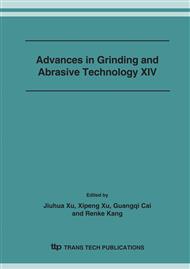p.384
p.389
p.394
p.399
p.404
p.409
p.414
p.420
p.425
Effect of Nozzle Type and Abrasive on Machinablity in Micro Abrasive Air Jet Machining of Glass
Abstract:
Micro abrasive jet machining (MAJM) is a high effective economical technology for three dimensional micro structure fabrications of brittle materials. It is widely used in the fabrication of semiconductors, electronic devices, micro electro-mechanical systems (MEMS), optical-electronic and optical devices, and medical instruments. In this paper, based on the experimental study of MAJM for glass, the influences of the nozzle type/size and abrasive type on the material erosion rate and structure profile are analyzed. The results show that the rectangular nozzle can yield a more accurate and efficient machining performance due to reduced flux effect. By contrast, with round nozzle all the cross section profiles of the machined patterns show rounded V-type shape. The rectangular nozzle is able to produce geometry with flat shape. The machining area is almost independent of the abrasive hardness, and the erosion rate increases with the increase in the hardness of the abrasive grits. The nozzle geometry is of great importance for machining accuracy and the efficiency.
Info:
Periodical:
Pages:
404-408
Citation:
Online since:
November 2007
Authors:
Price:
Сopyright:
© 2008 Trans Tech Publications Ltd. All Rights Reserved
Share:
Citation:


